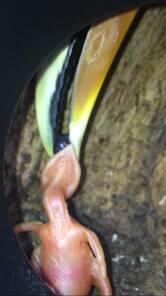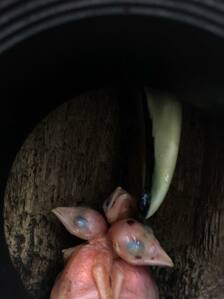Artificial Rearing
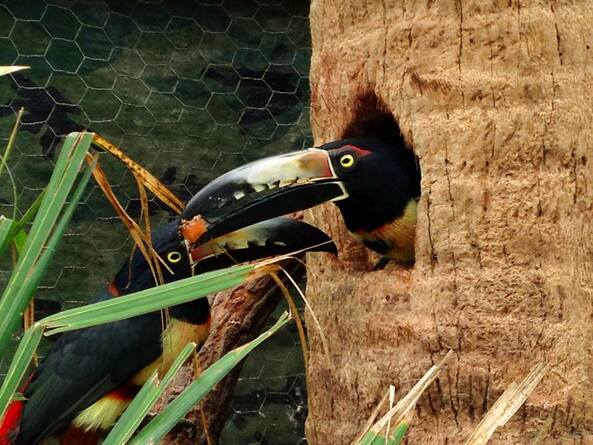
Although keeping Aracaris as pets is not too difficult, breeding them is an entirely different task. Various challenges face the potential breeder, including making compatible pairs, finding suitable nesting logs and then dealing with the very real possibility of needing to artificially incubate and hand-rear the offspring. It would be impossible to cover every aspect of breeding these amazing birds here but we will discuss the basics.
nesting
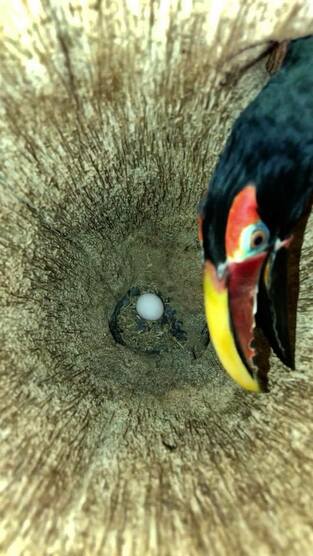
In nature, Aracaris utilize tree hollows in order to raise their young. Often, they are various species of palm, however many different types of trees may be used. The hollow may only be partially opened at first, but the birds will use their strong beaks to continue to excavate the hole until it meets their specifications. This also helps to reinforce the pair bond and stimulate laying. Note that, while in nature, it is common for Aracari spp. to live and even breed in family groups with relatives helping to raise the young, in captivity, they are more commonly bred in individual pairs.
When breeding Aracaris in captivity, it is still best to provide a natural log (palm preferred), for breeding. It is instinctive for these birds to want to excavate and they will attempt to do so no matter what the nesting chamber is made of. If it is too hard they can actually break their beaks while hammering at the bottom. Additionally, the parents will continue to work the bottom of the nest chamber while feeding chicks. This helps keep the chicks clean as they remove the debris along with log material. If you must use a box then I suggest using wood construction only. An inner diameter of 6" or so is ample for most smaller species. A depth of 24" is a minimum and 36" is better. Shredded cypress mulch can then be added to the box, filling it to within a few inches of the entrance hole. It is important to pack this down as hard as you possibly can. I have used a sledgehammer as a tamping rod to pack it very tightly. This will allow the birds to excavate in a somewhat natural way. However, don't be surprised if the box is emptied in a matter of hours. As long as there is some material left on the bottom of the box success is still possible.
When breeding Aracaris in captivity, it is still best to provide a natural log (palm preferred), for breeding. It is instinctive for these birds to want to excavate and they will attempt to do so no matter what the nesting chamber is made of. If it is too hard they can actually break their beaks while hammering at the bottom. Additionally, the parents will continue to work the bottom of the nest chamber while feeding chicks. This helps keep the chicks clean as they remove the debris along with log material. If you must use a box then I suggest using wood construction only. An inner diameter of 6" or so is ample for most smaller species. A depth of 24" is a minimum and 36" is better. Shredded cypress mulch can then be added to the box, filling it to within a few inches of the entrance hole. It is important to pack this down as hard as you possibly can. I have used a sledgehammer as a tamping rod to pack it very tightly. This will allow the birds to excavate in a somewhat natural way. However, don't be surprised if the box is emptied in a matter of hours. As long as there is some material left on the bottom of the box success is still possible.
|
|
Aracaris get very excited when inspecting potential nest logs! |
Egg laying
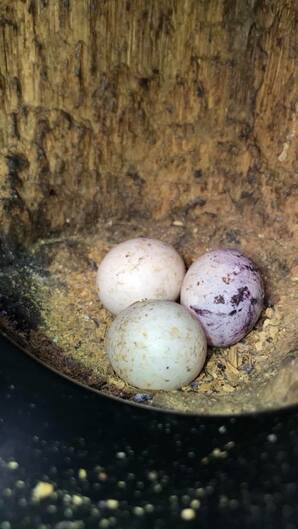
Once the pair are happy with the state of their nest chamber, the female will lay her eggs. Normally, one egg is laid each day until the clutch (3-4 eggs) is complete. Incubation starts with the laying of the first egg and is shared by both parents. I have heard so many "rules" about which parent sits when, and who feeds who, but I have found none of them really apply universally. Each pair is different with some males setting more often than some hens, while other pairs do just the opposite. It is not unusual for the eggs to be left unattended for periods throughout the day, especially when conditions are warm. Incubation for Aracari spp. is 15 days. The chicks typically hatch a day apart, in the order in which they were laid.
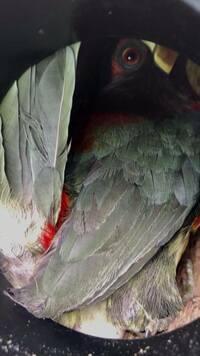
With their tail folded up against their back, the parents set tight on their eggs
chicks
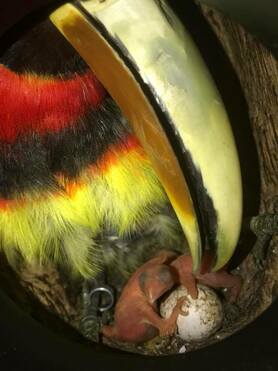
If all goes well, the chicks will start to hatch at 15 days. It is truly amazing to watch just how tender the parents can be. Using a beak many times larger than the tiny chicks, pieces of fruit are offered every few minutes during daylight hours.
